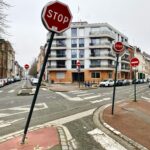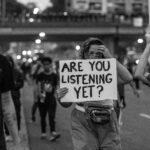

Image: Amnesty Maastricht International
This article is based on the lecture/discussion which took place at an event arranged between the Refugee Project Maastricht and Amnesty Maastricht on 26th March 2025. The discussion was led by Christine Doumbe, who provided a presentation and facilitated a Q&A session. This article is intended for readers who are curious to learn more about the current political crisis in the DRC, the human rights perspective, and the complications of international actors’ involvement in the DR Congo.
Congo, also known as the Democratic Republic of the Congo (DRC), is a country located in central Africa. The DR Congo is the second-largest country in Africa, with a population of over 105.8 million as of 2023. The country gained independence from Belgium in June 1960. DR Congo has been going through ongoing conflicts for more than three decades since the wake of Rwanda’s genocide in 1994.
Christine introduced her presentation on the ongoing political conflict by providing a brief background on the historical context and the rise of the M-23 armed group. Intensive conflict took place between 1993-2003, intensified by the 1994 genocide case in Rwanda. In 1994, it was reportedly recorded that 800,000 people were killed within 3 months in Rwanda. According to Amnesty International, Africa’s World War (First Congo War: 1996-1997 and the Second Congo War: 1998-2003 involved numerous African nations and armed groups fighting on the Congolese land. Numerous armed groups have been evolving and forming alliances to gain political power. The M23 rebel group was one of 100 armed groups fighting Congolese forces in the DR Congo.

During the discussion between Christine and the participants, M23 was often mentioned. M23 emerged in 2012 to fight against the Congolese government because the government had failed to implement the 2009 agreement in terms of integrating Tutsi fighters, an ethnic armed group, into the army, protecting minorities, and distributing resources evenly. M23 rapidly gained control over critical territories in eastern DRC, including Goma. It was defeated in 2013 as a result of the UN peacekeeping mission. Many of its fighters fled to neighbouring countries such as Rwanda and Uganda. However, M23 regrouped its army in late 2021 and launched new attacks in 2022, which have continued to till present – 2025.
The discussion also focused on human rights violations. According to the UN, M23 has committed serious violations of international law, including the targeting of women and children during the armed conflicts in the DRC by killing, sexual violence, abduction, and forced displacement. In the case of capturing Goma, the M23 has raided hospitals, abducted patients, including civilians, and hospitalised Congolese forces, being tortured. The U.N. Refugee agency raised concerns as the war had forced around 350,000 people to become displaced, with no roof over their heads.

A participant also asked about the mining sector and the involvement of international actors in the DRC’s crisis. Christine explained how miners working in the mining sector in Congo have faced many difficult issues. Much of the work of artisanal miners is conducted using poor tools and in extremely dangerous working conditions, impacting badly on the miners’ safety and well-being. Critical and fatal accidents on mine sites are regularly reported by the media and NGOs. For instance, a gold mine collapsed in 2020 and cost the lives of at least 50 people. In the mining sector of the DRC, artisanal miners are only paid low wages for the extraction of minerals, and they are exploited by powerful individuals, including political figures and armed groups. During the discussion, it was pointed out that some international actors are allegedly believed to be turning a blind eye to the human rights abuses in the mine sites while cooperating with essential local actors to gain economic benefits from the minerals.
Regarding mine sites in Congo, the country plays a vital role in resources required by the superpower countries such as the US, China, and the EU. The DRC has incredible deposits of gold, cobalt, lithium, and high-grade copper. In 2022, the DRC was the world’s largest cobalt miner with a production of 130,000 tons, nearly 68% of the world’s cobalt. The international actors are highly interested in the Congo’s reserves of cobalt and lithium because those kinds of mineral resources are essential for the production of batteries, smartphones, electric vehicles, and jet engines. During the US-China competition over the critical mineral resources in DR Congo, despite although US’s effort in the competition, China is still the dominant actor because Chinese firms control over 80% of Congo’s copper mines and hold a similar position for cobalt extraction according to Lobito Corridor Investment Promotion Authority.

Regarding the EU’s position on the DR Congo, the EU is under pressure to reconsider its mineral partnership with Rwanda. In 2023, the EU officially endorsed a roadmap for its strategic partnership (a €300-billion infrastructure partnership plan) with the DRC on raw materials. In 2024, Brussels signed an agreement with Rwanda’s government in exchange for funding to develop Rwanda’s mineral supply chains and infrastructure. More than €900 million is allocated to Rwanda. The EU has called for the suspension of the mineral deal with Rwanda because the US, EU, and UN all claim that Rwanda provides funding and military assistance to the M23 rebel group, which continues to fuel the current political conflict in the DR Congo. Currently, the Rwanda-backed M23 controls parts of the mineral-rich North Kivu province in eastern DRC and is reportedly advancing through its attacks into the South Kivu province. These major escalations are considered a violation of international laws, with officials in Brussels now reconsidering the EU’s partnership with Rwanda.
During the event, there were many reflections and observations as to any improvement of the ongoing political unrest, who are supporting the side of DRC, how the international community should respond to the escalating conflict in terms of peacekeeping measures, and partnership on mineral resources.
This article was written by Sai Kwan Hsai and edited by John Shotton. Photography by Alaïa Lafleur